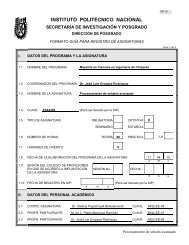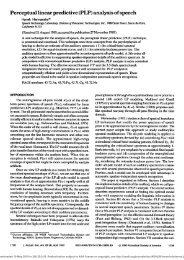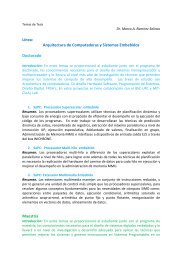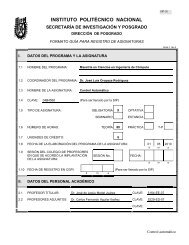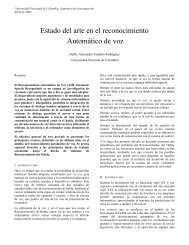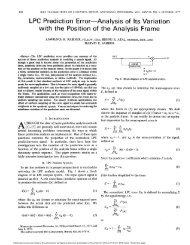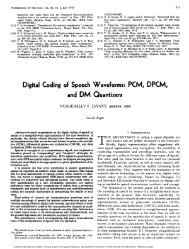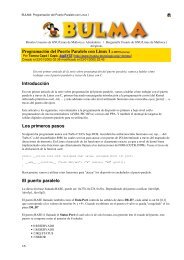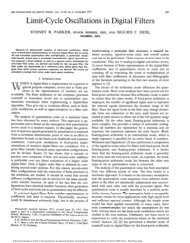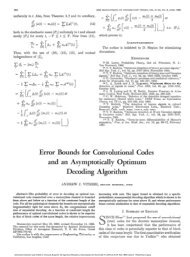Suggested Formulae for Calculating Auditory-filter Bandwidths and ...
Suggested Formulae for Calculating Auditory-filter Bandwidths and ...
Suggested Formulae for Calculating Auditory-filter Bandwidths and ...
Create successful ePaper yourself
Turn your PDF publications into a flip-book with our unique Google optimized e-Paper software.
summed. Notice that the summation must be done in linearpower, not in dB. An example is given in Fig. 4 <strong>for</strong> a complextone consisting of the first 12 harmonics ofa 200-Hz fundamental,all components having equal amplitude. The derivationcould be made more accurate by taking into accounthetransmission characteristics of the outer <strong>and</strong> middle ear.IV. LIMITATIONSThe ERB values estimated here apply to young listenersat moderate sound levels. The ERB tends to increase withage (Patterson et al., 1982) <strong>and</strong> with increasing sound level(Weber, 1977; Pick, 1980}. The values will also vary some-what from one listener to another. The assumption of <strong>filter</strong>symmetry is probably only va/id at moderate sound levels(Patterson <strong>and</strong> Nimmo-Smith, 1980}. With increasing soundlevel the low-frequency slope of the <strong>filter</strong> becomeshallower<strong>and</strong> the high-frequency slope become somewhat steeper.Note that these changes are the opposite way round fromthose in excitation patterns. [The reason <strong>for</strong> this can be illustratedby Fig. 3; the high-frequency side of the excitationpattern (points d <strong>and</strong> e in the lower half) is determined by thelow-frequency slopes of <strong>filter</strong>s with center frequencies abovethat of the stimulus.] Further work is needed to quantifythese changes be<strong>for</strong>e excitation patterns can be derived overa wide range of levels. The method of deriving excitationpatterns from <strong>filter</strong> shapes, unlike the more "direct" methodsusing masked audiograms, is not affected by combinationtone detection (Greenwood, 1971} or by off-frequencylistening {Patterson, 1976; Verschuure, 1978).All of the estimates of <strong>filter</strong> shape <strong>and</strong> ERB described inthis paper were derived <strong>for</strong> simultaneous masking. Thus theresults do not reflect the influence of suppression (Houtgast,1974). Suppression will have the effect of sharpening the <strong>filter</strong>shape derived in nonsimultaneous masking (H0utgast,1977; Moore <strong>and</strong> Glasberg, 1981), <strong>and</strong> correspondinglyof sharpening excitation patterns (Moore <strong>and</strong> Glasberg,1982). The degree of sharpening may vary with stimulustype, <strong>and</strong> is not predictable on the basis of linear <strong>filter</strong>ingIGlasberg et al., 1983).ACKNOWLEDGMENTSWe are grateful to Roy Patterson <strong>and</strong> Ian Nimmo-Smith <strong>for</strong> many helpful discussions, <strong>and</strong> <strong>for</strong> the use of theircomputer programs. Roy Patterson provided constructivecriticism of an earlier version of this paper. We thank LorraineEvans <strong>for</strong> typing the manuscript <strong>and</strong> Roy Hammans<strong>for</strong> help with the figures. This work was supported by theMedical Research Council.Fidell, S., Horonjeff, R., Teffeteller, S., <strong>and</strong> Green, D. M. (1983)."Effectivemasking b<strong>and</strong>widths at low frequencies," J. Acoust. Soc. Am. 73, 628-638 0983}.Fletcher, H. (1940)."<strong>Auditory</strong> patterns," Rev. Mod. Phys. 12, 47-65.Glasberg, B. R., Moore, B.C. J., <strong>and</strong> Nimmo-Smith, I. 11983}. "Comparisonof auditory <strong>filter</strong> shapes derived with three different maskers,"J.Acoust. Soc. Am. {submitted}.Greenwood, D. D. (1971)."Aural combination tones <strong>and</strong> auditory masking,"J. Acoust. Soc. Am. $0, 502-543.Houtgast, T. (1974}."Lateral suppression in hearing," thesis, Free Universityof Amsterdam {Academische Pers, B. V., Amsterdam).Houtgast, T. (1977)."<strong>Auditory</strong>-<strong>filter</strong> characteristics derived from directmaskingdata <strong>and</strong> pulsation-threshold data with a rippled-noise masker,"J. Acoust. Soc. Am. 62, 409-415.Maiwaid, D. {1967}. "Die Berechnung yon Modulationsschwellen mit Hilfeeines Funktionsschemas," Acustica 18, 193-207.Moore, B.C. J (1982)..4 n Introduction to the Psychology of Hearing, 2rid. ed.{Academic, London}.Moore, B.C. J., <strong>and</strong> G!asberg, B. R. 11981}. "<strong>Auditory</strong> <strong>filter</strong> shapes derivedin simultaneous <strong>and</strong> <strong>for</strong>ward masking," J. Acoust. Soc. Am. 70, 1003-1014.Moore, B.C. J., <strong>and</strong> Glasberg, B. R. (1982}."Interpretingthe role of suppressionin psychophysical tuning curves," J. Acoust. Soc. Am. 72, 1375-1379.Patterson, R. D. (1976)."<strong>Auditory</strong> <strong>filter</strong> shapes derived with noise stimuli,"J. Acoust. Soc. Am. 59, 640-654.Patterson, R. D., <strong>and</strong> Nimmo-Smith, I. (1980)."Off-frequencylistening <strong>and</strong>auditory-<strong>filter</strong> asymmetry," J. Acoust. Soc. Am. 67, 229-245.Patterson, R. D., Nimmo-Smith, I., Weber, D. L., <strong>and</strong> Milroy, R: (1982)."The deterioration of hearing with age: Frequency selectivity, the criticalratio, the audiogram <strong>and</strong> speech threshold," J. Acoust. Soc. Am. 72,1788-1803.Pick, G. F. (1980}."Level dependence of psychophysical frequency resolution<strong>and</strong> auditory <strong>filter</strong> shape," J. Acoust. Soc. Am. 68, 1085-1095.Plomp, R. (1976)..4spects of Tone Sensation (Academic, London}.Scharf, B. {1970)."Critical b<strong>and</strong>s," in Foundations of Modern •quditory Theory,Vol. I, edited by J. V. Tobias {Academic, New York}.Shailer, M. J., <strong>and</strong> Moore, B.C. J. (1983}."Gap detection as a function offrequency, b<strong>and</strong>width, <strong>and</strong> level," J. Acoust. Soc. Am. 74, 467-473(1983).Verschuure, J. (1978)."<strong>Auditory</strong> excitation patterns," thesis, Erasmus University,Rotterdam (W. D. Meinema, B. ¾., Delft).Weber, D. L. {1977)."Growth of masking <strong>and</strong> the auditory <strong>filter</strong>," J.Acoust. Soc. Am. 62, 424-429.Zwicker, E., <strong>and</strong> Feidtkeller, R. (1967). Das Ohrals Nachrichtenempfanger(Hirzel, Stuttgart}.Zwicker, E., Fiottorp, G., <strong>and</strong> Stevens, S.S. (1957)."Critical b<strong>and</strong>width inloudness summation," J. Acoust. Soc. Am. •9, 548-557.Zwicker, E., <strong>and</strong> Scharf, B. {1965)."A model of loudnes summation,"Psych. Rev. 72, 3-26.Zwicker, E., <strong>and</strong> Terbardt, E. •1980)."Analytical expressions <strong>for</strong> criticalb<strong>and</strong>rate <strong>and</strong> critical b<strong>and</strong>width as a function of frequency," J. Acoust.Soc. Am. 68, 1523-1525.753 J. Acoust. Sec. Am.. VoL 74, No. 3, September 1983 B.C.J. Moore <strong>and</strong> B. R. Glasberg: <strong>Auditory</strong>-<strong>filter</strong> b<strong>and</strong>widths 753wnloaded 10 May 2010 to 200.39.9.109. Redistribution subject to ASA license or copyright; see http://asadl.org/journals/doc/ASALIB-home/info/terms.js



